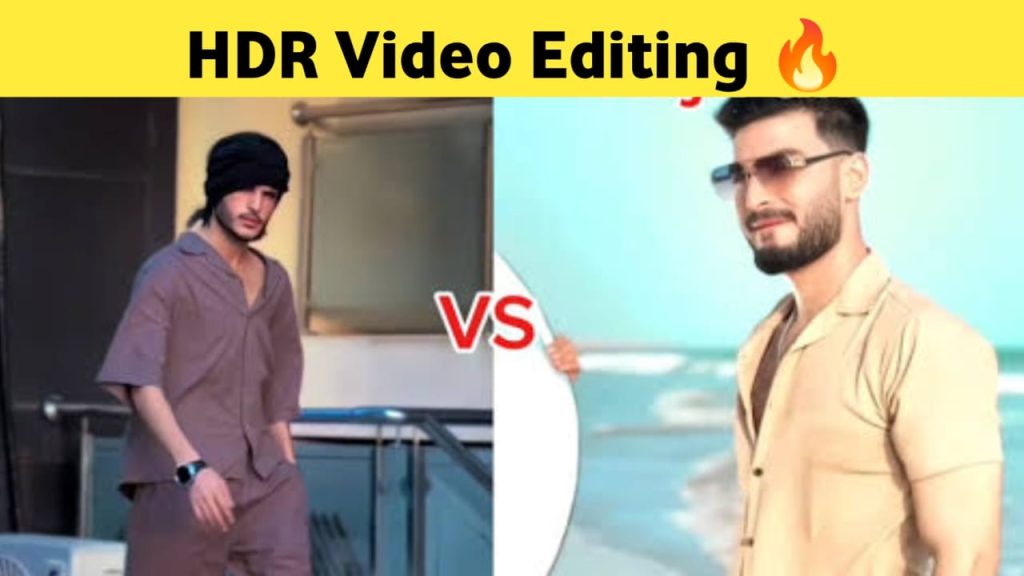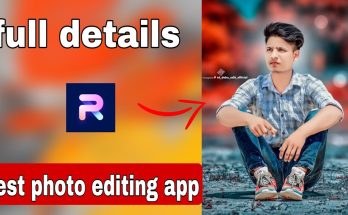Remember the first time you saw a truly breathtaking sunset on a high-quality TV? The way the clouds glowed with fiery oranges and deep purples, while the shadows on the ground held detail instead of disappearing into blackness? That visceral impact is the magic of High Dynamic Range (HDR). While HDR TVs and displays are increasingly common, the vast library of existing video content – from cherished home movies to classic films – remains trapped in Standard Dynamic Range (SDR). But what if you could unlock that hidden potential? Converting video to HDR isn’t just a buzzword; it’s a transformative process that can elevate your viewing experience dramatically. Let’s dive into the vibrant world of HDR conversion. HDR Video Editing App
What Exactly is HDR? More Than Just Brighter Pixels
HDR isn’t merely about making everything brighter. It’s about capturing and displaying a wider spectrum of light and color than traditional SDR can handle. Think of it like this:
- Dynamic Range: This refers to the difference between the darkest blacks and the brightest whites a screen can produce simultaneously. SDR is limited; HDR dramatically expands this range.
- Color Volume: HDR works hand-in-hand with wider color gamuts (like Rec.2020 or DCI-P3), meaning it can display many more subtle shades and more saturated, lifelike colors that SDR simply cannot reproduce.
- Brightness (Nits): HDR content specifies brightness levels far exceeding SDR’s typical 100 nits. Highlights (like sunlight, explosions, or specular reflections) can reach 1000, 4000, or even 10,000 nits on capable displays, creating a much more realistic and impactful sense of light.
The result? Deeper, more detailed shadows that aren’t just murky black holes. Brilliant highlights that pop with realism without washing out the entire image. Colors that look richer, more natural, and more vibrant. It adds depth, dimensionality, and a sense of “being there” that SDR struggles to match.

Why Convert SDR to HDR? Breathing New Life into Your Library
You might wonder: “Why not just shoot in HDR from the start?” Absolutely, that’s the ideal scenario! However, the reality is that mountains of incredible content exist solely in SDR:
- Legacy Film & TV: Countless cinematic masterpieces and beloved TV shows were shot and mastered in SDR. Converting them allows a new generation to experience them with enhanced visual fidelity on modern displays.
- Home Video Archives: Your precious family videos, vacations, and milestones captured on older camcorders or smartphones are likely SDR. HDR conversion can revitalize these memories, making colors more lifelike and details clearer.
- Content Creators: If you produce video but didn’t shoot in HDR, offering an HDR version can significantly enhance the perceived quality for viewers with compatible devices, setting your work apart.
- Future-Proofing: As HDR adoption grows, having your content available in HDR ensures it remains visually relevant and impactful on the best displays.
Converting SDR to HDR isn’t about creating “fake” HDR; it’s about intelligently remapping the existing visual information to utilize the expanded capabilities of HDR displays, revealing nuances often lost in the SDR version.
The Conversion Conundrum: It’s Not Magic (But It’s Getting Close)
Converting SDR to HDR isn’t a simple one-click filter. SDR lacks the inherent extra brightness and color range information that natively shot HDR possesses. The core challenge is intelligent extrapolation:
- Recovering Highlight Detail: SDR clips bright values at its peak white. Conversion algorithms must interpret how those clipped highlights might have looked and reconstruct believable, extended highlight detail without looking artificial.
- Expanding the Midtones & Shadows: It’s not just about making brights brighter. Effective conversion involves carefully stretching the midtones and shadows to utilize the HDR range, revealing subtle details in darker areas without introducing noise or unnatural “lifted” blacks.
- Color Gamut Mapping: SDR colors (Rec.709) need to be mapped to the wider HDR color gamut (like P3 or Rec.2020). This requires sophisticated algorithms to enhance saturation and luminance in a way that feels natural, not garish.
- Avoiding Artifacts: Poor conversion can lead to halos around bright objects, color banding, unnatural contrast shifts, or amplified noise. Quality is paramount.
The Toolbox: How SDR Becomes HDR
Several approaches exist, ranging from fully automated to highly manual:
- AI-Powered Conversion (The Cutting Edge):
- How it Works: This is the most exciting development. Advanced AI models are trained on vast datasets of SDR/HDR pairs. They learn complex relationships – how specific SDR values correlate to expanded HDR ranges in similar scenes (e.g., how a sunset sky in SDR should look when expanded in HDR). They predict missing highlight detail, optimize contrast locally, and enhance colors contextually.
- Pros: Relatively fast, becoming more accessible, can produce surprisingly good results with minimal user input, handles complex scenes better than simple methods.
- Cons: Results vary significantly between tools and models; high-quality AI conversion can be computationally expensive; risk of the AI applying an unnatural “look” if not well-trained.
- Examples: Topaz Labs Video AI, specialized plugins for DaVinci Resolve/Premiere Pro, emerging cloud services.
- Manual Grading (The Professional Gold Standard):
- How it Works: A skilled colorist uses professional grading software (like DaVinci Resolve) to manually transform the SDR image into HDR. This involves:
- Setting the correct HDR output format (HDR10, HLG, Dolby Vision).
- Carefully adjusting the overall tonal range (lift, gamma, gain) to utilize the HDR brightness scale.
- Using power windows (masks) and qualifiers to selectively brighten highlights and recover shadow detail.
- Applying sophisticated color transforms and saturation adjustments for the wider gamut.
- Meticulously shot-matching for consistency.
- Pros: Offers the highest potential quality and complete artistic control. Can achieve results indistinguishable from native HDR when done exceptionally well.
- Cons: Extremely time-consuming, requires deep expertise and specialized (expensive) software/hardware (HDR reference monitor), impractical for large volumes of content.
- How it Works: A skilled colorist uses professional grading software (like DaVinci Resolve) to manually transform the SDR image into HDR. This involves:
- Basic LUTs & Presets (The Quick & Dirty Approach):
- How it Works: Apply a Look-Up Table (LUT) or preset effect designed to “simulate” HDR. These often just aggressively boost brightness and saturation.
- Pros: Very fast, easy, cheap (often free).
- Cons: Results are usually poor. They lack the intelligent scene-by-scene adjustments of AI or manual grading. They frequently cause clipping (loss of highlight detail), crushed shadows, unnaturally oversaturated colors, banding, and an overall artificial, harsh look. Generally not recommended for true HDR conversion.
Choosing Your Path: A Practical Guide for Conversion
Ready to try converting your own videos? Here’s a roadmap:
- Source Quality is King: Start with the highest quality SDR source possible. A heavily compressed, noisy YouTube rip won’t convert well. Use original files or high-bitrate exports.
- Define Your Goal: Are you future-proofing home movies, experimenting with a short film, or producing a professional release? This dictates the effort and tools needed.
- Select Your Weapon:
- For Experimentation/Ease (Home Videos, Social Clips): Explore reputable AI tools like Topaz Video AI. They often offer free trials. Look for specific “SDR to HDR” models.
- For Professional Results (Short Films, Critical Projects): Invest time (or budget) in manual grading using DaVinci Resolve (which has a free version with strong HDR tools, though a reference monitor is crucial for accuracy). Consider hiring a colorist.
- Avoid: Simple LUTs/presets marketed as instant HDR fixes.
- Understand the Output: Know your target HDR format:
- HDR10: Most common, static metadata.
- HLG: Good for broadcast, backward compatible with SDR TVs.
- Dolby Vision: Premium, dynamic metadata (requires licensing for creation).
- Mastering & Delivery: HDR files are larger. Use appropriate codecs (like HEVC/H.265) and bitrates. Platforms like YouTube and Vimeo support HDR uploads (check their specific requirements for formats like HLG or HDR10). Ensure your playback device (TV, monitor) and software support HDR.
The Future is Bright: Where HDR Conversion is Headed
AI is rapidly evolving the SDR-to-HDR landscape. Expect:
- More Sophisticated AI Models: Models that better understand scene context, object recognition, and artistic intent, producing even more natural and higher-quality conversions.
- Real-Time Conversion: Potential for live conversion during streaming or playback on powerful devices.
- Democratization: High-quality conversion becoming faster, cheaper, and integrated into more consumer and prosumer editing software.
- Focus on Creator Tools: Easier workflows within editing suites for creators to offer SDR and HDR versions of their work.
Is Converting to HDR Worth It? The Verdict
The answer is a qualified yes, but manage expectations.
- For cherished memories or important projects: Absolutely. AI tools, while not perfect, can genuinely revitalize old footage, making colors pop and revealing details you might not have noticed before. The emotional impact of seeing a family memory with enhanced clarity can be significant.
- For professional content delivery: If done exceptionally well (manual grading), it can add tremendous value and future-proof your work. AI tools are becoming viable for certain professional applications, especially with oversight.
- For instant perfection on any clip? No. Don’t expect miracles from cheap plugins or poorly implemented AI. Native HDR capture is always superior. Conversion is an enhancement process, not true magic.
Converting video to HDR is about unlocking potential. It takes the visual information already present in your SDR footage and intelligently maps it to the breathtaking canvas offered by modern HDR displays. While the technology is still maturing, the results, especially with advanced AI and skilled artistry, can be genuinely transformative. So, dig out those old videos, fire up a conversion tool, and prepare to see your world in a whole new, brilliantly dynamic light. The era of flat, limited SDR is fading; the vibrant, detailed world of HDR awaits your content.




